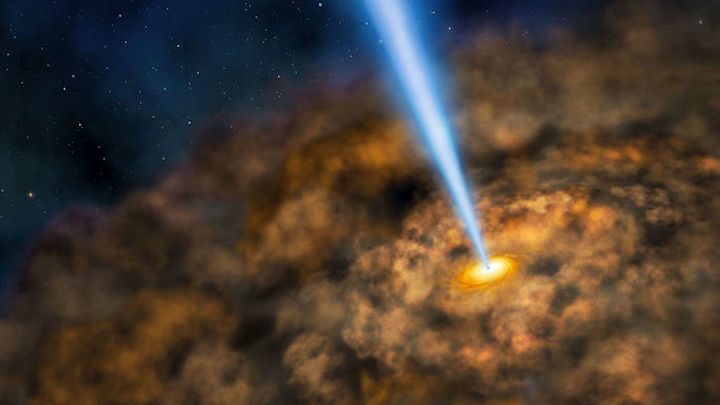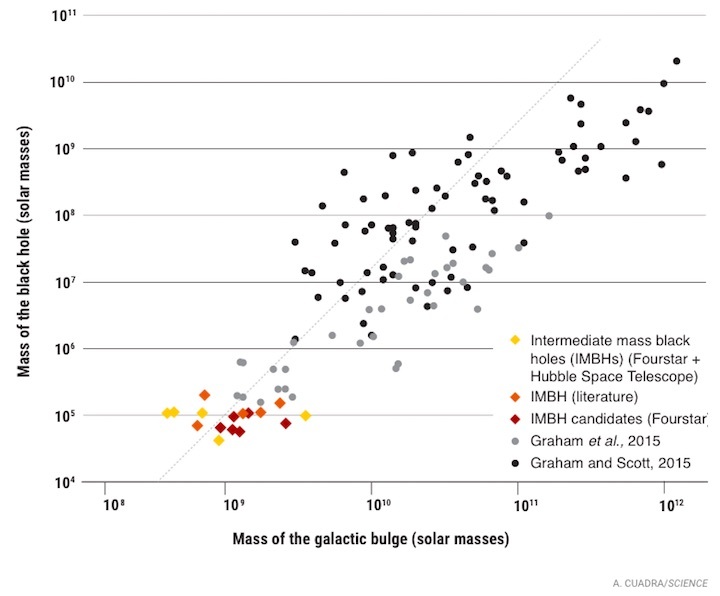1.06.2018

At the center of a galaxy, a giant black hole powers a jet of ionized gas.
LYNETTE COOK/SOFIA/NASA
-
How did giant black holes grow so big? Astronomers have long had evidence of baby black holes with masses of no more than tens of suns, and of million– or billion–solar-mass behemoths lurking at the centers of galaxies. But middle-size ones, with thousands or tens of thousands of solar masses, seemed to be missing. Their absence forced theorists to propose that supermassive black holes didn’t grow gradually by slowly consuming matter, but somehow emerged as ready-made giants.
Now, astronomers appear to have located some missing middleweights. An international team has scoured an archive of galaxy spectra and found more than 300 small galaxies that have the signature of intermediate mass black holes (IMBHs) in their cores. They confirmed that 10 of those candidates really do have middleweight black holes by consulting other data sets, raising their confidence that the original list “must include at least a few dozen genuine [IMBHs],” says team leader Igor Chilingarian of the Smithsonian Astrophysical Observatory in Cambridge, Massachusetts.
Ezequiel Treister of the Pontifical Catholic University of Chile in Santiago, who was not involved in the study, salutes the team’s detective work. “Black hole measurements are really hard; we’ve been trying to do this for many years.” Volker Bromm of the University of Texas in Austin says the team’s technique is “pretty original” and calls their work “careful and responsible.” The findings, researchers say, could begin to unravel the mystery of supermassive black hole formation.
Black holes of any size are hard to find because they don’t emit light of their own. They can reveal themselves by sucking in nearby gas and dust, heating it so fiercely along the way that it emits x-rays. X-rays pouring from the centers of many galaxies betray the presence of supermassive black holes, known as active galactic nuclei (AGNs). But the x-ray signal of an IMBH would be faint, and existing x-ray satellites are geared toward detailed observations of distant sources, not wide-ranging surveys of multiple galaxies. The archive from NASA’s Chandra X-ray Observatory, for example, only covers 2.5% of the sky.
So Chilingarian’s team searched for an alternative, visible-light signal in a catalog of 930,000 galaxy spectra gathered by the Sloan Digital Sky Survey (SDSS). The x-rays produced by an AGN ionize clouds of hydrogen gas in the galactic bulge around it, setting them aglow at particular frequencies that produce distinct peaks in the galaxy’s spectrum. The clouds closest to the black hole swirl around it at high speed, which shifts the frequencies via the Doppler effect and smears out each spectral peak. Gas clouds farther out move more slowly, so the peaks remain sharp. To identify galaxies that have a small AGN, the team looked for spectral peaks that were sharp at the top but smeared out around the base.
Black holes grow with their galaxies
Black holes, including the newly discovered middleweights, have masses that correlate with the size of their host galaxy.

The search of the SDSS catalog yielded 305 candidates. Because other short-lived phenomena could mimic the key signal, the team also checked other surveys, gathered at different times, to be sure the candidate galaxies showed the same smeared peaks. They also inspected some of the galaxies themselves with the Giant Magellan Telescope in Chile. But the real clincher of an AGN is the telltale x-ray signal, so the team searched archived observations from NASA’s Chandra and Swift satellites and Europe’s X-ray Multi-Mirror Mission to see whether, by chance, they had observed any of those candidates. The result was a final short list of 10, the team reports in a paper posted on arXiv and submitted to The Astrophysical Journal.
Even that small number challenges recent thinking about how supermassive black holes formed. Theorists needed alternatives to a simple scenario of gradual growth not just because IMBHs were missing, but also because astronomers have identified giant quasars—very luminous AGNs—shining when the universe was less than a billion years old. “How could very massive black holes grow so big” at that early time, asks theorist Avi Loeb of Harvard University.
Loeb and others proposed that in the early universe, huge clouds of gas collapsed directly into giant black holes, between 100,000 and 1 million times the mass of the sun, which formed the seeds of the early quasars. That scenario would explain both the speed of formation and the lack of IMBHs.
The new result suggests, however, that at least some supermassive black holes grew from smaller seeds. The 10 confirmed IMBHs fit a pattern of gradual growth: Their masses correlate with the size of galactic bulge around them, suggesting each black hole is growing in step with its host. Treister says the obvious conclusion is that “there is not one scenario: both happen. Now, the question is, which is more common?”
Bromm says direct collapse might have been possible only in the very early universe because the building material for stars and galaxies was different back then. The big bang generated only hydrogen and a bit of helium. Heavier elements joined the mix millions of years later, after early stars forged those elements and then dispersed them when they died. Once present, the heavier elements helped the primordial gas cool because they became ionized at high temperatures, causing the gas to glow and shed heat. A cooler gas cloud is more likely to fragment into many stars—the seeds of small black holes. In contrast, a hot cloud could collapse into a single giant object, with a little help from the gravitational pull of dark matter, Bromm suggests. It would be a rare occurrence, he admits, something of a “cosmic miracle.”
The only way to find out which scenario dominates is to find more middleweights. The hurdle, Chilingarian says, is the lack of x-ray surveys. A German-built x-ray survey telescope called eROSITA is expected to be launched later this year or early next year on board the Russian observatory Spektr-RG. “It’ll produce a very nice data set,” Chilingarian says. He’s betting it will yield hundreds more confirmed IMBHs—and shed more light on black hole origins.
Quelle: Science
